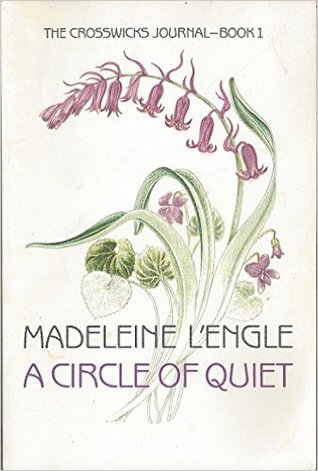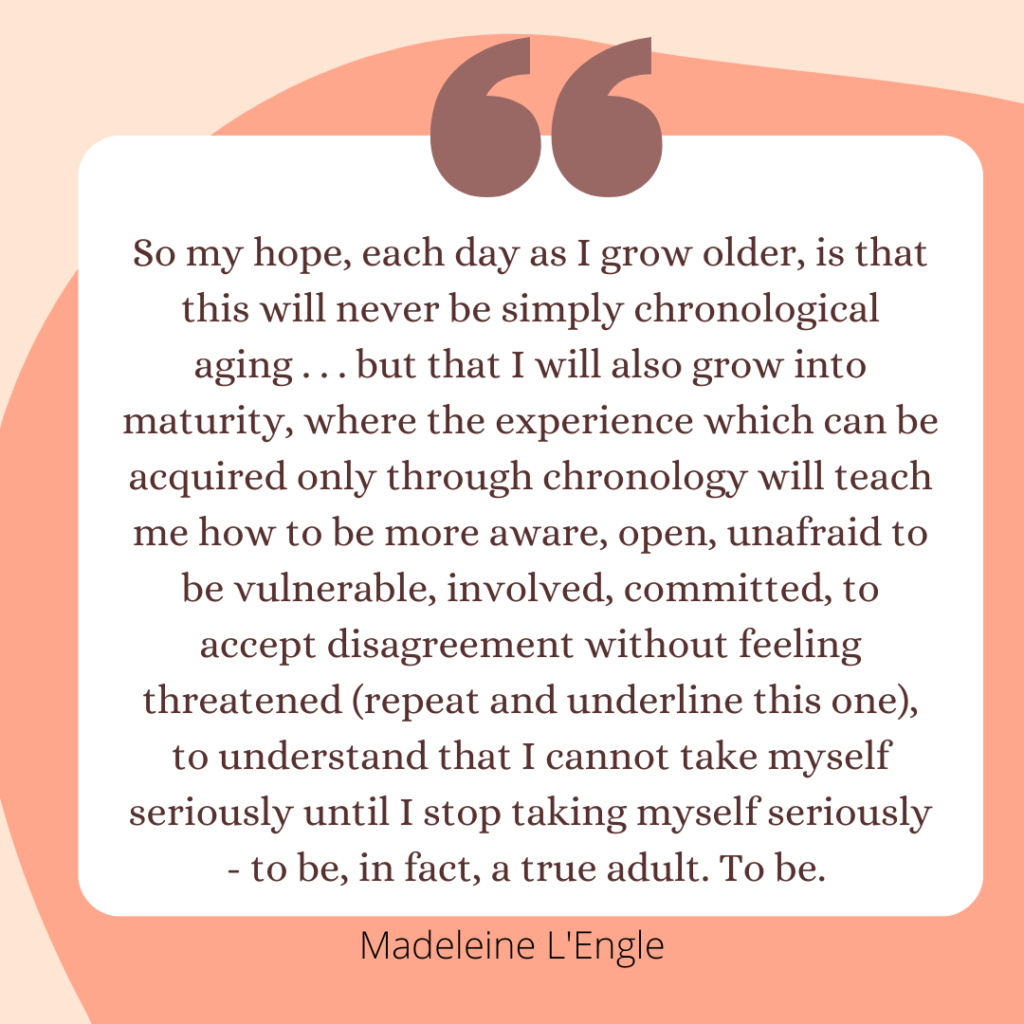Do you have a book that feels like an old friend, one that you pick up to read often? And as you read, you feel yourself settling in as if in a comforting conversation. That’s how it is with A Circle of Quiet by Madeleine L’Engle. I started reading L’Engle’s journal in 1995 during the school winter holidays, and it became a tradition for me to pick up that book every December, right after Christmas, for several years.
L’Engle begins by explaining that there are four generations of family under her roof the summer she is writing.
“Every so often, I need OUT; something will throw me into total disproportion, and I have to get away from everybody–away from all these people I love most in the world–in order to regain a sense of proportion. … My special place is a small brook in a green glade, a circle of quiet from which there is no visible sign of human beings. … If I set for a while, then my impatience, crossness, frustration, are indeed annihilated, and my sense of humor returns” (pg. 4).
I didn’t have a large household in the late 90s and early 21st century, but I spent long days in school. I used the winter holidays to reset – to “regain a sense of proportion!” Being “on” at school was a challenge for this introvert!
On Isness
A Circle of Quiet resonated in so many ways! I have dozens of favorite passages from the short book. L’Engle writes about writing, her faith, our essential inner selves, and more. Her discussion of “is-ness” early in the book captures my imagination and reminds me that we are not sufficient unto ourselves – we are meant for community. And our beings are not static. Only as we grow in self-awareness can we accept who we really are and allow the Spirit of God to transform us.
“I suppose the perfect isness of anything would be frightening without the hope of God. An oak tree is, and it doesn’t matter to it—at least Sartre thinks it doesn’t; it is not a thinking oak. Man is; it matters to him; this is terrifying unless it matters to God, too, because this is the only possible reason we can matter to ourselves: not because we are sufficient unto ourselves—I am not: my husband, my family, my friends give me my meaning and, in a sense, my being, so that I know that I, like the burning bush, or the oak tree, am ontological: essential: real” (pg. 8).
“A self is always becoming. Being does mean becoming, but we run so fast that it is only when we seem to stop—as sitting on the rock at the brook—that we are aware of our own isness, of being. But certainly this is not static, for this awareness of being is always a way of moving from the selfish self—the self-image—and towards the real. Who am I, then? Who are you” (pg. 32)?
On Teaching
L’Engle describes her work as a Writer in Residence, working with educators, “reading fellows,” a special set of seminars. She writes about the significance of teaching children, the weighty responsibility but also about teaching creativity, even about defining the words we use in our disciplines to be sure we are all on the same page.
“There are educationists (as jargon has it) who think that creativity itself can be taught, and who write learned, and frequently dull, treatises on methods of teaching it. It is rather as though they were trying to eat air, with the usual result. The creative impulse, like love, can be killed, but it cannot be taught. What a teacher or librarian or parent can do, in working with children, is to give the flame enough oxygen so that it can burn. As far as I’m concerned, this providing of oxygen is one of the noblest of all vocations” (pg. 45-46).
Have you ever had a teacher who provided the oxygen for your learning? Or maybe you were the teacher who fanned the flames of discovery for others!?
L’Engle wrote this idea long before our emphasis on multiple choice testing –
“But children want to know, and perhaps it is our desire not to let them down that has led us into the mistake of teaching them only the answerables. This is a mistake, and we mustn’t refuse to allow them to ask the unanswerables just because we can’t provide tidy little answers” (p. 204).
I would have loved to pick Madeleine L’Engle’s brain on education and curriculum. I often wrestle with how we determine what every child needs to know and who should inform what children learn in school.
If we could all learn this truth – allow people to be different! Curiosity is essential!
“How do we teach a child—our own, or those in a classroom—to have compassion: to allow people to be different; to understand that like is not equal; to experiment; to laugh; to love; to accept the fact that the most important questions a human being can ask do not have—or need—answers” (pg. 44).
On Faith
L’Engle first fell in love with the scripture as a child. She loved stories and storytelling. In her words, the Bible was a “book of stories of unqualified people.” Later she came to know the God of scripture. But in her search to understand Christianity, she said, “If only my friends would admit that it was a mystery and stop giving me explanations!” I can appreciate that. In her book on faith and art, she said, “We live by revelation, as Christians, as artists, which means that we must be careful never to get set into rigid molds. The minute we begin to think we know all the answers, we forget the questions, and we become smug like the Pharisee who listed all his considerable virtues, and thanked God that he was not like other men.”
Again I am struck by how current her writing is even today. People are leaving the church today because it doesn’t appear that even those attending church believe what they say they believe. The church, in general, has been cruel to people. But like L’Engle, I have hope! And I believe the church has been seeded with both wheat and weeds and it is being sifted, purified. The true church will prevail!
“Many people who have rejected the church today have done so because the establishment which calls itself Christian so often behaves in an unchristian manner; because, in the name of Christ, we have so often been intolerably cruel to other human beings. Too many priests and ministers have been seduced by the post-Christian world. Within it, however, lies the tiny, almost extinguished flame of the Christian world, kept alive by the often ignored remnant. If I do not feel despair at the state of the world today it is because I have an eager hope that the Christian world is going to be born again—not a reversion to the first years, but a breaking forth into something new and living and brilliant” (pg. 170).
There are many more thoughts I could share, but let me just say, if you haven’t read Madeleine L’Engle’s journals, there are three of them. A Circle of Quiet is by far my favorite of the three, but they are all rich in language and thought! A Circle of Quiet has influenced my love for writing and my love for God and His people.
A Song of Hope
All my hope on God is founded;
he doth still my trust renew.
Me through change and chance he guideth,
only good and only true.
God unknown,
he alone
calls my heart to be his own.Human pride and earthly glory,
sword and crown betray his trust;
what with care and toil he buildeth,
tower and temple fall to dust.
But God’s power,
hour by hour,
is my temple and my tower.God’s great goodness aye endureth,
deep his wisdom, passing thought:
splendor, light, and life attend him,
beauty springeth out of naught.
Evermore
from his store
new-born worlds rise and adore.Daily doth th’ Almighty giver
bounteous gifts on us bestow;
his desire our soul delighteth,
pleasure leads us where we go.
Love doth stand
at his hand;
joy doth wait on his command.Still from earth to God eternal
Translator: Robert Bridges; Author: Joachim Neander
sacrifice of praise be done,
high above all praises praising
for the gift of Christ his Son.
Christ doth call
one and all:
ye who follow shall not fall.
Next Week: Leap Over a Wall by Eugene Peterson
Reference: L’Engle, M. (1972). A Circle of Quiet (Crosswicks Journals #1). HarperSanFrancisco.

